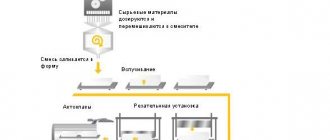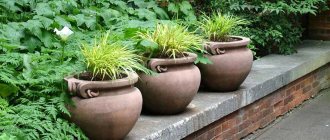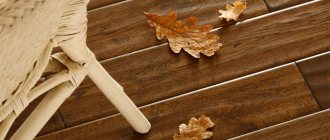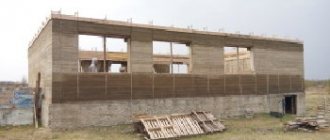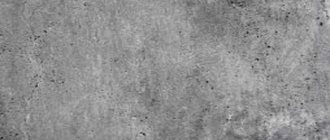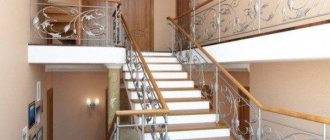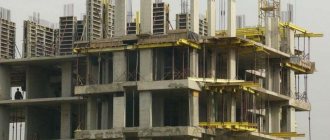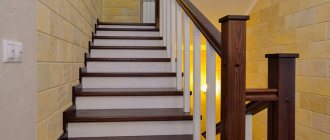Fiberglass concrete for decoration
Improvements in construction technologies help improve the performance of traditional construction materials. New developments are increasingly appearing, which are characterized by unique properties and application features.
Facade glass fiber reinforced concrete is a concrete composite reinforced with glass reinforcement, which is evenly distributed throughout the entire mass of material. Facade decor made from glass fiber reinforced concrete can decorate any building and give it originality.
What is glass fiber reinforced concrete
Glass fiber reinforced concrete is a modern unified building composite material, which is obtained by mixing plasticized concrete and cut glass fiber. Glass monofilament, used in this case for reinforcement, increases the compressive-tensile strength tens of times compared to concrete. Experts say that in terms of its technical parameters, fiber-reinforced concrete is almost perfect and has excellent prospects in construction. This material has many advantages:
- low weight due to hollowness;
- insignificant load on walls and supporting structures;
- works well for bending and stretching;
- resistant to shrinkage cracks;
- successfully resists moisture, alkalis and acids.
In addition, glass fiber reinforced concrete has low thermal conductivity, excellent sound insulation, resists fire better than concrete, withstands shock loads well, and is not susceptible to corrosion processes. The pliable plasticity of this material is truly unique. He has no competitors in this regard. Excellent compatibility with inorganic dyes allows you to give the material any colors and shades.
Fiber-reinforced concrete can change or repeat the relief of almost any working surface. Design engineers have already appreciated this advantage of SFRC, thanks to which it is possible to strictly follow any architectural style during the construction and renovation of buildings, use details with intricate ornaments and massive three-dimensional cornices. The ability to create small forms of architecture, manufacture porticoes, protective screens from ultraviolet rays, frame window and door openings makes this material indispensable for finishing buildings. It is in perfect harmony both with the surrounding landscape and with neighboring buildings and structures.
The dense material hardens quickly and has high strength even in a small layer, which makes it possible to produce thin-walled products with a smooth surface. The thickness of the plates in this case does not exceed 1 cm. Fiber-reinforced concrete can imitate other materials and take complex shapes. As a material for facade decoration, it easily replaces plaster, concrete and gypsum stucco, can compete with tiles and slate on roofs, and compete with classic reinforced concrete in terms of installation of interfloor ceilings. The low weight of SFRC reduces the load on load-bearing walls and foundations, which makes it possible to increase the number of storeys in buildings.
Description of material
Glass roving is a component that, after crushing, is added to the concrete composite.
The strength characteristics of concrete are enhanced by the fact that the internal filler has the same length and uniform distribution. As for traditional concrete, which is based on a sand-gravel mixture, it does not have sufficient strength relative to compressive and tensile loads. Glass fiber in concrete solution improves the performance characteristics of the material and products based on it.
Shredded glass fiber
Important! Glass fiber reinforced concrete is characterized by: high density, rapid hardening and mechanical strength of a relatively small layer.
Adding Glass Fiber to Concrete Composite
In the production of this material, there are some stages of preparing a traditional concrete mixture - preparing the components and mixing them. You can prepare the material yourself; instructions for this will be given below.
Colored glass fiber reinforced concrete decor
Important! Making a reinforced composite yourself will save money.
Application of glass fiber reinforced concrete
In addition to the construction and restoration of historical buildings, this material is now actively used in landscaping, as well as in other areas, for example, as permanent formwork. SFB is also used:
- for cladding overpasses in spans, tunnels, drainage systems on high-speed highways;
- during the construction of compact format cleaning facilities in car parks, multi-storey garages and car wash premises;
- for the production of ventilated louvres and containers for landscaping.
Recreation areas for citizens (parks, public gardens) can also be modified using glass fiber reinforced concrete, adding creative appeal. The designer can easily create a whole range of beautiful objects: cozy benches, beautiful flower beds, convenient garbage disposals, original fountains. The standardized material can also be successfully used in the construction of bridges, creating unusual parapets and structures that suppress vehicle noise. Despite their large length, SFRC elements do not exert a significant load on the bridge. But better than concrete, they protect reinforcement and structures from external influences: acid rain, substances containing chlorine, etc.
Positive qualities of the material
Finishing the facade using glass fiber reinforced concrete
Glass fiber is used to reinforce a composite based on a traditional concrete mixture.
Reinforcement is always aimed at increasing the strength characteristics of the mass, but if we compare traditional concrete reinforced with steel rods, concrete with glass fiber has distinctive positive qualities:
- Fiberglass is not at risk of corrosion;
Stucco molding made of glass fiber reinforced concrete
- When stretched and compressed, the material has higher strength;
Decorating the façade of a private house with SFRC products
- Glass fiber has significantly less weight than steel reinforcement, so products made from such concrete are lighter;
Facade decor made of fiber-reinforced concrete
- If we compare steel reinforcement and glass fiber located in the array, then the latter is characterized by an increased total cross-sectional area;
SFRC keystone
- Due to the high plasticity of SFRC, which is based on a fine-grained concrete matrix, which sometimes does not even contain sand, it is possible to create a texture of any given property and parameters.
Modern building with decorative SFRC inserts on the facade
Reinforced concrete products are reinforced with heavy steel reinforcement, which significantly increases their weight. In addition, steel reinforcement needs protection from corrosion and moisture, for which a certain distance is maintained between the reinforcement bars and the edges of the surface. Glass fiber reinforced concrete composite does not have these disadvantages.
Balusters from SFB
Products made from glass fiber reinforced concrete are characterized by the following positive qualities:
- They are compact in size;
Fiberglass concrete: facade decor
- Light weight, which allows them to be used for decorating building facades;
Installation of decorative elements on the building facade
- They are characterized by high strength and resistance to environmental influences;
Method for installing decorative parts made of SFRC on the facade of a building
- Highly decorative and different shapes, thanks to high plasticity;
Decorative elements made of glass fiber reinforced concrete
- The decorative surface of the products has a polished smooth surface;
The amazing plasticity of the material allows you to create highly decorative elements on the facade
- Increasing the decorative effect is possible by introducing dyes and fibers of different colors into the solution;
Painting SFRC elements
- Due to the high strength of glass fiber reinforced concrete, it is possible to produce decorative thin-walled products.
Column made of SFB
Important! This material is used for the manufacture of curtain and ventilated facades, wall and cladding materials, and tiles.
Decorating the facade using SFRC
To summarize, we can highlight the following positive qualities of reinforced concrete composite:
- High strength of the material in tension and compression;
SFRC columns on the facade
- Stability during bending;
Decorating the facade with glass fiber reinforced concrete
- The products are light in weight, which facilitates the process of transporting them to the installation site, facilitates the work of installing the products and does not place a significant load on the base of the building;
Fiberglass concrete for decorating the facade with columns and balusters
- The material is not afraid of low ambient temperatures;
SFB facade decor
- The products have high impact resistance, that is, they are not destroyed by impact;
Decorative fencing made of SFRC
- The high density of the material ensures its rapid hardening;
Photo of an arch from SFB
- Products can have complex configurations due to the high plasticity of the material;
Decorative element made of SFRC
- The glass fiber included in the composite is not exposed to chemicals.
Decorative fencing made of SFRC in landscape design
The material is not resistant to alkali, but this disadvantage is offset by the presence of glass fiber, which is resistant to these substances.
The upper decorative part of the column is made of SFRC
Important! Due to the rapid hardening of this type of concrete, its laying should be done faster.
Possibilities of glass fiber reinforced concrete
In modern design and construction conditions, new requirements are placed on buildings and structures. Their essence is a strict desire for greater architectural expressiveness, adherence to a certain style, and increased attractiveness of facades. Fiber-reinforced concrete, which has unlimited possibilities due to its unique properties, primarily ductility and strength, can provide invaluable assistance in solving future urban planning problems. It can be successfully used to make both thin and voluminous decorative elements. It is difficult for concrete to keep up with GFRC, which is 5 times stronger in tension, 15 times better able to withstand impact loads, its frost resistance has been increased to 300 cycles (for concrete - 50), and most importantly, glass fiber reinforced concrete does not contain heavy crushed stone and reinforcement, so increasing weight. On the one hand, it can reproduce the contours of a building with amazing accuracy, on the other, it can change its appearance beyond recognition. In addition to the existing advantages, special additives are used in the production of glass fiber reinforced concrete to improve its forming, technological and operational properties. Another advantage of the popular material is its convincing copying of various textures. It can be successfully adapted to wood, sandstone, fireclay, slate, which has significantly expanded the scope of use of SFRC, making building facades individual, memorable, and diverse.
Glass fiber reinforced concrete in architecture
SFRC is perhaps the only material today that allows you to accurately reproduce any architectural style, including modern trends and those that have long gone down in history. However, buildings built in the styles of classicism, gothic, rococo, empire and others have reached us. Restoring such rarities is a complex and painstaking task, sometimes requiring the repetition of complex contours. Most finishing materials cannot provide such precision as fiber-reinforced concrete, which demonstrates amazing properties. Thanks to him, majestic columns and elegant pilasters, original balustrades and porticos breathing history, airy cornices and strict corner elements acquire their pristine appearance. The unique material not only accurately copies the details, but also conveys the spirit of the era in which buildings of historical value were built. A house lined with fiberglass concrete will last a long time. In the West, the warranty period for such facades is 50 years. But this material has been used there for the second century. In Russia, it has just begun its victorious march, but its production is increasing in arithmetic progression. After finishing with SFRC, both modern and ancient buildings look equally good - beautiful, reliable, durable.
Architects and designers, having such a trump card in their hands, can no longer limit their imagination by inventing original architectural forms. Thanks to the new material, any, even the most daring decisions, will be brought to life. The appearance of cities will begin to gradually change, parting with the typical, unmemorable “boxes”.
Glass fiber reinforced concrete facades
A popular material for cladding facades is glass fiber reinforced concrete, which demonstrates resistance to aggressive materials, environmental friendliness, impact resistance and relatively low weight. Glass fiber reinforced concrete simultaneously provides all the basic advantages of gypsum, concrete and expanded polystyrene. It is also valued for its low specific gravity, optimal water absorption and high resistance to cold and hot temperatures.
A unique, innovative material - glass fiber reinforced concrete, specially developed by scientists and intended for the manufacture of a wide variety of facade decorative elements. With its help, you can completely restore a building that has the most complex architectural forms and is decorated with a variety of decorative elements. To produce glass fiber reinforced concrete, the following components are used in special proportions:
- quartz sand;
- cement M-500 and higher grades;
- fiberglass.
The composition of the material is based on a mixture of concrete and sand, filled with finely cut glass monofilament - fiber. It works as follows: ordinary concrete under external influence often bursts and cracks, first of all, at the edges. The presence of long threads in the mixture, arranged in a chaotic manner, significantly increases the strength of any product regarding the impact on it both in terms of strength and tensile strength. As a result, a material is produced that has the following positive characteristics:
- high strength;
- environmental Safety;
- high plasticity;
- economical use.
Production
Glass fiber reinforced concrete is made on the basis of Portland cement M 500-700 (white or gray), fine quartz sand and alkali-resistant glass fiber (roving) with additives that improve the aesthetic, molding, technological, and operational properties of the material
Products are manufactured from several methods. The most common technological schemes are pneumatic injection of the mixture and vibroforming of the premix (or premixing), i.e. preliminary mixing of chopped fiberglass with cement-sand mortar. Relying on our many years of experience, we use pneumatic spray. This method involves the use of a special pneumatic gun, which ensures the simultaneous application of chopped fiberglass and cement-sand mortar to the surface or form. The components of the mixture are mixed at the outlet of the gun nozzle, the fiber is evenly “blown” into the solution, resulting in a homogeneous layer of glass fiber cement being placed in the mold.
The advantage of the method is that the solution can be prepared separately, the fiber is crushed in a gun immediately before mixing, the dosage of the material is clear, and the mixing is fast and uniform. You can compare the properties of the material depending on the production method:
Stucco decor made from glass fiber reinforced concrete
There are many options for designing the original facade of a building. One of the most advantageous is the use of molded decorative elements made of fiber-reinforced concrete. This is how decorated with stucco moldings appear:
- majestic columns and pilasters;
- brackets and consoles supporting balconies and window sills;
- medallions;
- balustrades;
- crowning, basement, interfloor cornices;
- door and window trim elements.
The frames of the stucco arches look beautiful. If desired, you can create entire bas-reliefs on the walls. Architectural expressiveness and entertainment only benefit from this. Sometimes lighting is installed in the cornices, and at night such buildings acquire an aura of fabulousness.
Molded elements made of glass fiber reinforced concrete are also used when installing railings, pedestals for sculptures, and installing fences around the perimeter of the building. You can create entire architectural ensembles in the same style, deviating from the usual cliches. For example, the arrangement of a country plot for the estate of a wealthy landowner would look unusual. The house, outbuildings, terrace, gazebos - everything will breathe the 19th century, thanks to the efforts of the architects, where stucco decorative elements will take a significant place.
With a creative approach to business, it is possible to implement many interesting ideas. Take, for example, this type of façade decor such as medallions, which are round or oval shaped elements with a smooth surface. Previously, they were left in their original form. Nowadays you can see medallions, the surface of which is decorated with ornaments, paintings, mosaics, and carved reliefs. Such stucco elements look more attractive and create a feeling of well-being and sophistication.
Both in the decoration of modern buildings and in the restoration of old buildings, stucco plays an important role. It is she who gives completeness to the style. Molded elements made of gypsum, standing for decades (or even centuries), tend to fall off over time, which creates a danger to others. Gypsum stucco is heavy, which is why it tends downwards under the influence of gravity. This is facilitated by unfavorable climatic conditions, the influence of moisture, vibration, and mechanical stress. Glass fiber reinforced concrete, thanks to its light weight and modern adhesives, holds up perfectly without creating problems. It is not afraid of frost, heat, wind, or vibration - it is more than strong enough to withstand this.
Stucco elements are also used for interior decoration. In addition to the mentioned doors and windows, SFRC makes amazingly beautiful ceiling rosettes and baseboards, and chic mirror frames. At the same time, stucco molding can also be painted, playing with different colors and shades, which makes it possible to easily fit into any interior.
Types of facade panels made of fiber-reinforced concrete
There are types of facade panels made of fiber-reinforced concrete that imitate stone, metal, brick and wooden surfaces, as well as colored slab surfaces. At the same time, the imitation is of high quality, the texture and shades of the simulated surface are accurately repeated. The most commonly found types on sale are:
Fiber cement panels for brick
The texture can imitate both new fired brick and already aged brick. Slabs imitating brick and stone masonry are usually made in red, terracotta, beige, gray and yellow shades.
Stone-look facade panels
Fiber cement panels for exterior stone-like finishing make it possible to create the appearance of stone masonry on those facades where the use of natural material is impossible or impractical for economic reasons.
Products whose outer part is covered with stone chips deserve special attention. They not only have an excellent appearance, but also improve the strength and frost resistance of the product. Such panels are a 3-layer cake, the base of which is a fiber-reinforced concrete base, the back side is represented by a water-repellent coating, and the front side is represented by a composition based on polyester resins and stone chips.
Fiber cement wood panels
The texture of the material imitates natural materials such as natural pine, oak, larch or cedar as realistically as possible. If slabs with a brick finish give the facade of a building features of monumentality and durability, then fiber cement panels with a wood look instill a feeling of warmth and comfort.
Construction from glass fiber reinforced concrete
SFRC curtain panels have found wide application in the reconstruction of buildings and monolithic housing construction. The plasticity of the material, interesting relief and color solutions make it possible not only to radically update facades, but also to fundamentally change the appearance of buildings undergoing modernization. Decorative tiles made on the basis of Danish super-white cement are used to decorate the hinged ventilated facades of high-rise buildings. In low-rise construction, multilayer panels with lightweight thermal insulation and cladding made of glass fiber reinforced concrete sheets are used. When constructing cottages, large-sized panels of combined roofing were used, the relief of which imitates natural tiles. When arranging the basement floors, panels and slabs made of SFRC are used, imitating granite, marble and other types of natural stone. Prefabricated pavilions and small trading floors also cannot do without the use of this material. Swimming pools with bowls made of fiber-reinforced concrete began to appear in country houses and cottages. The structures are designed for a long service life, which is facilitated by the high operational and technical characteristics of the material.
But the advantages of SFB are most fully manifested in the construction of religious objects and restoration of historical buildings. The fiber mixture easily repeats any shape of the matrix, allowing you to obtain exact copies of the relief, architectural ornaments, and drawings. In this case, there is no need for plaster overlays. The decoration of temple complexes requires the presence of architectural elements of increased complexity, for example, when cladding monolithic minarets of a mosque or domes of an Orthodox church. The new material successfully solves these problems, as in the case of restoration of historical heritage sites, where elements made of glass fiber reinforced concrete carry a double load. In addition to their decorative role, they also reliably protect the walls of the building from the negative effects of precipitation and winds.
Areas of application of SFB
Balustrade on a balcony made of SFRC
The uncomplicated, simple plane of the facade is transformed and gains expressiveness thanks to all kinds of decorative fragments. When using glass fiber reinforced concrete, it is possible to create high-quality decorative elements that are reliable and durable.
Decorative elements from SFRC when decorating the facade of a country mansion
Due to its high performance characteristics, the material can be considered universal. Not only prefabricated monolithic objects are made from it, but also decorative fragments, and it is also used in the restoration of architectural monuments.
The material is used for the manufacture of:
- Hinged thin-walled panels, cladding materials and ventilated facades;
3D facade panel made of glass fiber reinforced concrete
- Architectural elements of buildings and restoration of facades;
Architectural elements of a building made of SFRC in a classic style
- Facade decor that successfully competes with concrete or gypsum stucco;
Stucco molding made of glass fiber reinforced concrete
- Durable fencing on loggias and balconies;
SFRC fencing
- Panel elements of stationary formwork structures;
- Plaster mixtures;
- Barriers with soundproofing properties;
- Decorative elements in landscape design;
Garden bench made of SFB
Important! Depending on the chemical composition and strength requirements of a particular product, glass fiber is selected.
- Elements of sewerage and drainage systems;
- For waterproofing;
- For the manufacture of pipelines;
- For the manufacture of plumbing fixtures.
Fountain from SFB
The special expressiveness of SFRC structures is achieved thanks to a wide range of colors and a variety of configurations. This makes it possible to produce sculptures and decorative fragments for facade decoration.
Glass fiber reinforced concrete products
Highly decorative SFRC
SFB is used for the manufacture of:
- Cladding panels;
Modern facade decorated with SFRC overlay panels
- Various architectural and decorative finishing elements;
Decorative products made from glass fiber reinforced concrete can be used in the interior
- Fencing for balconies and loggias;
Balusters for decorative fencing made of SFRC
- Cornices and trim of various shapes and sizes;
Rotunda cornice made of SFRC
- Window sills;
Window sills from SFB
- Thumb;
SFB cabinet
- Baluster;
Balusters made of glass fiber reinforced concrete
- Columns and pilasters;
SFRC columns
- Rosettes, panels and moldings;
SFB socket
- Facade stones with a castle, plinth or rusticated shape.
Rusts assembled with a “travertine” texture made of glass fiber reinforced concrete
It is possible to manufacture products according to individual sketches.
The video in this article will tell you how to choose the right decorative elements from glass fiber reinforced concrete.
Decorative products made from glass fiber reinforced concrete
Glass fiber reinforced concrete keystone for decorating building facades
With the help of decorative elements from SFRC, not only can the façade of a building be finished, but also the landscape can be designed in an urban area or in a suburban area. Glass fiber reinforced concrete is indispensable in restoration work, when it is necessary to accurately recreate lost or damaged fragments of the decor of historical buildings.
Facade elements made of glass fiber reinforced concrete
For the same reason, thanks to its innovative composition and plastic properties, this material allows you to put into practice the most daring design and architectural ideas.
Using SFB, any surface, texture and relief of an element can be imitated:
- Metal;
- Wood;
- Chamotte;
- Any natural stone;
- Travertine;
- Bronze;
- Cork and other materials.
Fiberglass concrete with wood imitation
Fiberglass concrete is essentially an artificial stone; it is environmentally friendly for humans and the environment.
SFB cornice
Installation of SFRC cornice
The top part of the roof or wall plane of a building is the cornice. This decorative element borders the perimeter of the building, protruding slightly above the plane of the wall. The use of interfloor cornice was common in the late 19th and early 20th centuries.
Cornice on the facade of a multi-storey residential building
Important! Despite the fact that cornices of any profile are made from SFRC, this does not mean that you can choose any element you like for the facade. When choosing a cornice, the style and type of structure must be taken into account. And the decorative cornice itself must be made taking into account the architectural standards of a separate order - the artistic style of design. Therefore, the main criteria when choosing a cornice are the proportions of the building, its dimensions, the presence of such decorative elements as cabinets, columns, pilasters, balusters.
Cornice on the facade of brick building elements
The advantage of glass fiber reinforced concrete in the manufacture of facade decor is its strength, resistance to mechanical loads and environmental influences. The parts are easy to install, can be painted to match the color of the walls, and are fire resistant.
Decorative elements made of glass fiber reinforced concrete
You can easily make any decorative element from glass fiber reinforced concrete, restoring the beautiful architectural elements generously donated to the current generation of the country by its great ancestors. The plasticity of SFRC allows you to reproduce any decorative elements, including those with complex, curved shapes, large-sized products and other details as needed.
The almost limitless possibilities of the material make it possible to produce a wide range of decorative parts, such as cornices for finishing basement floors, facades, and interfloor sections of walls. In demand:
- coffered and corner rusticated elements,
- pilasters,
- columns,
- capitals,
- balustrades,
- medallions,
- bas-reliefs.
A significant part of the volumes falls on facade panels, which cover large areas of walls when finishing buildings.
In addition, there are interesting solutions for arranging fences and fences made of glass fiber reinforced concrete. The low weight of the elements greatly facilitates installation, but it is preferable to carry it out by highly qualified specialists. This is due to the characteristics of the elements that must be taken into account during assembly. Facade panels are supplied together with fastening units, divided into two types: supporting and for fixing (limiting) products. The classic panel has 4 fixing nodes and two supporting ones. From the name it is clear that the latter take on the load-bearing load, while the fixing ones prevent the panel from moving after installation. The load is distributed evenly over the entire area of the façade panel fabric. During gusts of wind or shrinkage, all cladding panels must withstand stress without breaking or cracking.
Manufacturing
The creative process includes “nurturing” an idea and translating it into drawings. Next, you need to select the type of mold to fill, prepare it and mix the solution:
Preparation of the building mixture involves the use of Portland cement and crushed fiberglass.
- Portland cement, sand and water are mixed in a concrete mixer.
- Add crushed fiberglass (3-5%).
- Continue stirring for a few more minutes.
- Pour into the mold.
There are plastic, rubber and plywood sample forms. Rubber is intended for complex decoration parts, the rest - for large elements. You can buy the mold or model it yourself using plaster. Color solutions are created by adding dye to the liquid mass or by coloring the finished product.
If you have to work with fiberglass yourself, it is important to remember safety precautions by using gloves and goggles.
The table shows the manufacturing methods:
| Type of work | Tools used | Application method | Advantages |
| Industrial (with special equipment) | Mixer | Pneumatic spray | Strict dosing |
| Compressor | |||
| Pneumatic pistol | Kneading speed | ||
| Mass uniformity | |||
| Private | Manually | Vibration molding | Low cost |
| Concrete mixer |
Texture of glass fiber reinforced concrete
The texture of fiber-reinforced concrete, as well as the ability to apply any color scheme in accordance with the planned work, is another advantageous advantage of the material. Any shades that exactly correspond to the original plans of the architects or modern design requirements can be easily and reliably reproduced. In addition, the product is guaranteed to retain its color scheme for a long time.
The use of glass fiber as a filler and binder significantly reduces the weight of the product. As a result, the impressive dimensions of some decorative elements are light in weight, and they are easy and simple to work with, including fastening at height.
SFRC is used for the manufacture of a wide variety of decorative elements intended to decorate the facades of buildings. It can be:
- columns;
- cornices;
- porticos;
- capitals;
- pilasters;
- stucco decor;
- various sculptures and much more.
The popular material has recently been increasingly used in the design of any elements of landscape design, improvement of parks, public gardens, recreation areas and city attractions.
What does the SFB consist of?
Decorative elements made of fiber-reinforced concrete
The material has a simple composition:
- The binder is Portland cement M500;
- It is necessary to use fine sifted quartz sand as a filler;
- Glass fiber in the solution ranges from 3 to 5%;
- Water;
- The required color range, aesthetic appearance and technical qualities are provided thanks to additives.
SFB blocks
Important! In the production of SFRC, the binder plays an important role. Sometimes Portland cement is replaced with aluminous cement, which is characterized by intense crystallization while maintaining the strength of the mass and increasing the water resistance of the product. When exposed to moisture, Portland cement has a destructive effect on glass fiber, and serves as reliable protection for metal reinforcement. Due to the presence of calcium hydroxide in Portland cement, glass fibers break down.
Building facade with decorative elements made of SFRC
The disadvantages of aluminous cement include its high price and a possible decrease in strength if the manufacturing technology is violated.
Public building decorated with glass fiber reinforced concrete
When manufacturing SFRC, special attention should be paid to the choice of glass fiber, since its chemical component can vary and have different effects on the strength characteristics of the array.
Therefore, it is recommended to use the following as a reinforcing material:
- Alkali-resistant zirconium silicate thread;
- Fibers based on calcium-sodium silicates;
- Aluminum borosilicate fiber;
- Glass fillers based on silicate and quartz fibers.
Decorative balusters made of SFRC on the open terrace
Important! In order for the fibers to be distributed evenly, they must be thoroughly mixed in one direction.
Glass fiber reinforced concrete is a non-flammable material
In addition to all its advantages, SFB is also non-flammable. Its fire resistance is amazing. If you look at the properties of this material at vintage age, then in the “Combustibility” column there is zero. Recently, the requirements for premises in terms of fire safety have been radically revised. This means that close attention is now paid to the degree of fire resistance of building materials. Glass fiber reinforced concrete has managed to surpass concrete in this indicator as well. Being non-flammable, such a facade and walls of the building will be able to protect from fire. During a fire, when minutes count, this property of the material will help people evacuate the building in a timely manner. And if the roofing, interfloor ceilings, and interior decoration are made of SFRC, being inside such a house, you can feel relatively safe.
Advantages of glass fiber reinforced concrete
The unique material received its main advantages thanks to fiberglass, which dispersely reinforces SFRC. If you perform a calculation, it turns out that the total cross-section of glass fiber is larger than that of reinforcement bars, moreover, glass fiber is much lighter than steel, and its tensile strength is higher. A reinforced concrete block is made technologically larger than designed, hiding the reinforcement from moisture and corrosion deep into the block, away from its external surfaces. Glass fiber does not rust, allowing you to make a more compact, lighter, and therefore less expensive block with the same strength characteristics as concrete. Not subject to corrosion and the influence of aggressive environments, fiber-reinforced concrete is perfectly painted both in bulk and on the surface, when polished, an original texture is obtained. Under certain conditions, you can even get a translucent material that looks very original.
Environmentally friendly SFRC has one more advantage: the lack of shielding ability. Electromagnetic waves pass through it without being reflected. To them, this material looks completely transparent. When constructing residential buildings, the described property is extremely important. Modern apartments suffer from a large accumulation of electronics and household appliances that generate electromagnetic fields, which, when reflected and exposed to a person for a long time, can have a negative impact on the state of the body. Glass fiber reinforced concrete allows electromagnetic waves to pass through itself.
Equipment for glass fiber reinforced concrete
The demand for this unified material has raised the question of creating simple and reliable equipment for the production of glass fiber reinforced concrete. So that you can independently obtain in-demand building materials. With the help of modern technologies, it was possible to create high-quality and efficient equipment for the production of SFRC, the serial production of which has already been started by many domestic manufacturers.
It consists of a mortar pump station that processes the fiber-reinforced concrete mixture, and a mixer for the production of mortar, which is a necessary component of fiber-reinforced concrete. The volume of the station's loading hopper ranges from 80-100 liters, depending on the manufacturer. This makes it possible to obtain from 150 to 200 kg of mixture in one cycle. Loading can be done either mechanically or manually. Modern mortar pumping stations are quite maneuverable, thanks to swivel joints and wheels powered by a pneumatic system. The efficiency of a mixer is measured by the quality of the mixture produced, consisting of sand, cement and water.
To apply the finished SFRC to the working surface, special pneumatic spray guns are used, which are included in the list of equipment for mortar pumping stations. A distinctive feature of these single-nozzle devices is the possibility of spraying both large-area working surfaces and complicated ones: relief, patterned, etc. The mixture is supplied evenly to the prepared surface. Mixing of the working solution with fiberglass occurs directly in the working chamber of the gun, thanks to the high pressure of compressed air. To obtain fiber of a given length, guns are equipped with special units.
Decorative elements are also made in molds. To do this, the mixture is placed manually and vibrocompacted. To ensure a smooth surface of the products, the molds are pre-lined with plastic film. If the film is replaced with glass, you get a polished surface. Relief surfaces are achieved using silicone molds. But in all the mentioned cases, before laying the mixture, the forms must be lubricated with mineral oil.
Features of SFRC manufacturing
Private house decorated with applied decorative parts made of SFRC
SFRC can be manufactured in several ways.
- The composite composition can be applied pneumatically. For spraying, a special “gun” is used, with the help of which the sand-cement composition and glass fiber are supplied into the mold. The advantages of this method of manufacturing glass fiber reinforced concrete include the fact that the mixture is prepared separately.
SFRC production methods
Mixing occurs quickly and has a uniform consistency. The fiber is crushed as it exits the nozzle. The mechanized method of supplying material is distinguished by precise dosage. This method is not suitable for private production, since it will require purchasing expensive equipment.
Decorating the facade of a public building with glass fiber reinforced concrete
- The ingredients can be mixed manually or with a concrete mixer, so it is often used in private construction.
To make SFRC with your own hands, you will need to do the following:
- Using a concrete mixer, the sand-cement mixture of the required grade is mixed;
- Ground glass fibers are added;
- The mixture is stirred for 5 minutes;
- To increase the density of the product, after pouring the material into the mold, the vibration molding method is used.
Glass fiber reinforced concrete facade decor
Important! When grinding glass fibers, it is necessary to use personal protective equipment in the form of gloves and goggles.
